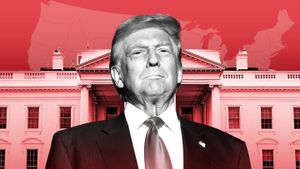Concerns Over Economic Depression Ride High as U.S. Introduces Tariffs on Mexican Imports
The U.S. government has unfurled plans for imposing hefty tariffs on imports from its neighboring countries, reigniting fears of significant economic repercussions, particularly for Mexico. With President Trump’s announcement on Thursday to implement 25% tariffs on U.S. imports from Mexico and Canada starting this Saturday, experts are sounding alarms about the potential fallout on both economies.
According to existing data, sales from Mexico to the United States accounted for around 30% of Mexico’s GDP in 2023, illustrating the countries’ tight-knit economic ties. This extensive dependence forms the crux of economic analysts' concerns. Gabriel Siller, director of analysis at Grupo Financiero Base, mentioned, "Under this scenario, the peso and the Canadian dollar are today the most depreciated currencies against the dollar," indicating immediate repercussions of the tariff announcement on foreign exchange rates. Following the news, the peso experienced depreciation of 1.01%, losing 20.7 centavos against the dollar, and closing at 20.7553 pesos per dollar.
International credit rating agency Moody’s Ratings reported on Monday, highlighting the implication of the tariff policy of the U.S. on Mexico's credit profile, currently rated at “Baa2” with a negative outlook. This uncertainty looms larger as financial experts predict significant contractions across various sectors within the Mexican economy, especially within the automotive, technology, and manufacturing realms.
"The threat to the bilateral trade relationship could significantly affect economic activity in both countries," claimed analysts at Deutsche Bank, emphasizing the pressures these tariffs would place on the U.S. economy, potentially leading to increased inflation rates. The imposition of tariffs could drive up consumer prices for Mexican goods, creating additional burdens on American households, and resulting in political ramifications for President Trump’s administration.
Recent reports from financial group Base forecast dramatic declines, predicting, "The tariffs would translate to increases in consumer prices for Mexico's products, which would lead to demand contraction." They estimate every 1% increase in prices would result in approximately 1.33% drop in export volumes. By their projections, if half of the 25% tariff is passed to U.S. consumers, Mexican exports could plummet by 12%.
On economic indicators, the longer the tariffs persist, the more detrimental impacts will emerge. Analysts from the Base brokerage noted, "The imposition of tariffs on Mexico would generate GDP contraction of 4.4%, maintaining everything else constant.” They caution this decline is not confined to 2025 alone and is likely to worsen over time, as the ramifications trickle down across industries reliant on these cross-border trade networks.
Concerns over employment following the tariffs are also warranted. Up until September 2023, nearly 2.9 million jobs stemmed from Mexico's export-driven manufacturing industry, representing about 13.04% of all formal employment registered with the IMSS. This indicates the potential for widespread job losses should the tariffs lead to quota limits and reduced production.
Expounding on the White House’s arithmetic, some experts view this current administration’s strategic approach as increasingly radical, constituting another notable shift within international trade relations. Commentators from Banamex, Nydia Iglesias and Sergio Kurczyn, stated, "Given this will be the last time Trump can govern the country, this administration appears to be leading toward bolder radicalism than during his first term." They reference the creation of the Office of International Taxation, providing hope for more extensive articulation of tariff policies.
Historical precedents suggest these protectionist policies often yield unintended consequences, reverberations felt throughout global supply chains. The expected economic ripple effects challenge sectoral stability and risk undermining previously coordinated relationships across the North American continent. Should tensions continue to escalate, observers warn of potential economic secession or serious diplomatic strife between the U.S. and its neighbors.
This looming economic predicament invites the question: Are these tariffs worth the impending fallout? Many analysts believe they are likely to cause economic disintegration instead of fostering growth or ensuring national security. Amidst rising fears of recession, stakeholders across the board would be wise to tread carefully as discussions around tariffs and trade continue.
While the situation is still developing, experts continue to monitor the markets closely, anticipating reactions from stakeholders, consumers, and businesses alike. With the tariffs set to roll out as planned, Americans and Mexicans alike brace for turbulent economic waters possibly unprecedented by the current administrations' previous fiscal policies.



